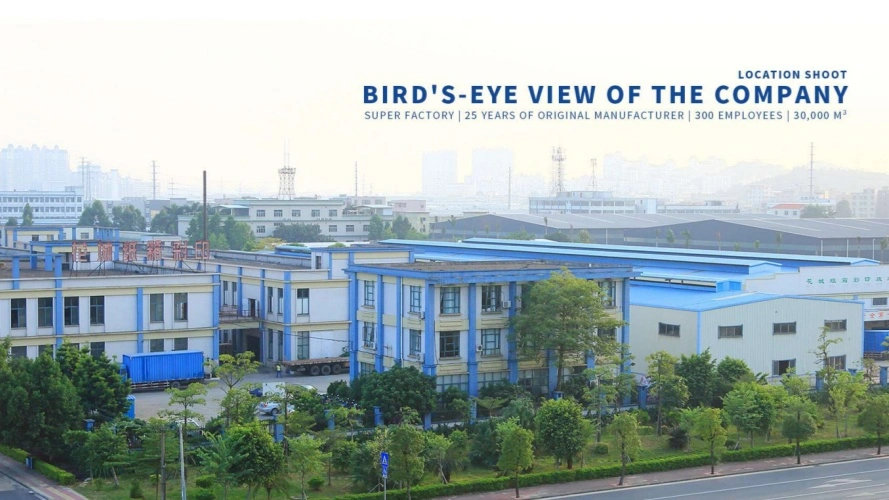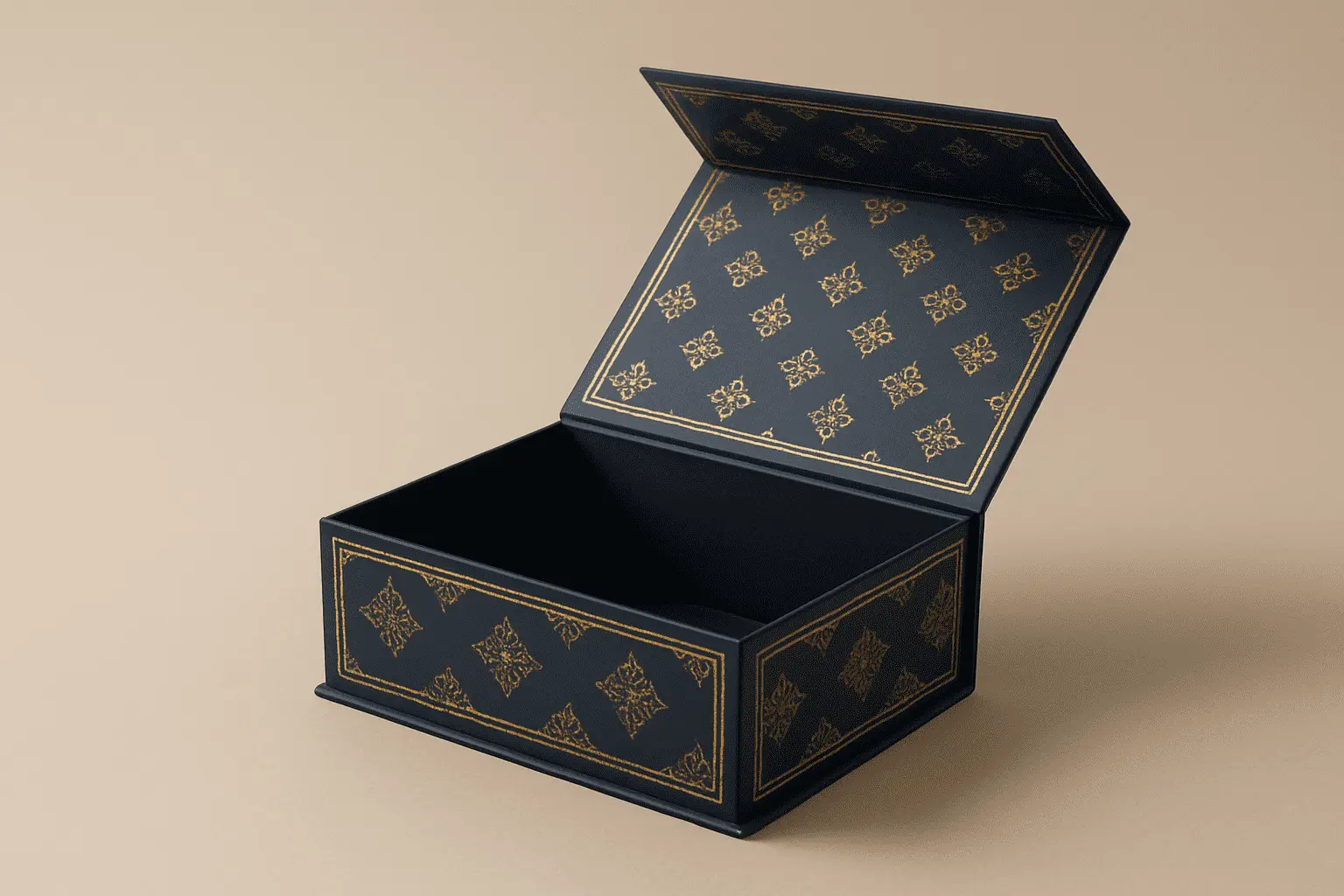Rigid Box vs Collapsible Rigid Box: Which Is Best for Luxury Gifts
Picture this: You've invested in premium products, crafted an exceptional brand identity, and now face the critical moment of choosing packaging. You want that unforgettable unboxing experience, but storage space is limited, shipping costs are escalating, and sustainability matters. The choice between rigid box packaging and collapsible rigid box designs can make or break your luxury gifting strategy. This comprehensive guide reveals exactly which option delivers maximum impact for your high-end products while addressing practical business concerns that keep brand managers awake at night.

Understanding Traditional Rigid Box Construction
Traditional rigid box packaging has long been the gold standard for luxury gift presentation, offering an unparalleled unboxing experience that immediately communicates premium quality. These sophisticated packaging solutions are constructed from heavyweight paperboard, typically three to four times thicker than standard folding cartons, creating a substantial feel that customers associate with high-value products. The rigid box structure maintains its shape permanently, never collapsing or folding, which provides exceptional protection for delicate items like jewelry, cosmetics, electronics, and high-end accessories. The manufacturing process for rigid boxes involves laminating decorative paper or specialty materials onto thick chipboard substrates. Grey chipboard and duplex chipboard are the most commonly used rigid materials, providing the foundational strength needed for luxury packaging. The exterior wrap can feature premium materials including SBS C1S or C2S paperboard, CCNB, brown kraft, or metallic papers, each offering distinct visual and tactile qualities. These materials support advanced printing technologies and finishing techniques that create stunning visual effects, from hot foil stamping and embossing to spot UV coating and holographic applications.
Key Advantages of Traditional Rigid Boxes
Traditional rigid box designs offer several compelling benefits that explain their continued dominance in luxury markets. The permanent structure provides superior product protection during shipping and handling, with thick walls that resist crushing and impact damage far better than folding cartons. This durability makes rigid boxes ideal for fragile items like glass perfume bottles, electronic devices, or delicate cosmetic products that require secure packaging throughout the distribution chain.
The unboxing experience with traditional rigid boxes creates memorable moments that strengthen brand loyalty and encourage social media sharing. When customers lift a substantial lid from a rigid box base, they encounter a sense of anticipation and occasion that folding boxes simply cannot replicate. This psychological impact translates directly into perceived product value, with consumers consistently rating products packaged in rigid boxes as more premium and desirable compared to identical items in standard packaging.
Traditional rigid boxes also excel in retail display applications where packaging serves as both protection and marketing tool. The sturdy construction allows boxes to stand upright on shelves without support, maintaining perfect alignment and visual appeal throughout the product lifecycle. Display windows can be incorporated without compromising structural integrity, allowing customers to preview products while maintaining protection. These boxes can be customized with magnetic closures, ribbon pulls, drawer mechanisms, and other interactive elements that enhance the tactile experience and reinforce brand sophistication.
The Innovation of Collapsible Rigid Box Design
Collapsible rigid box technology represents a breakthrough innovation that combines the luxury aesthetics of traditional rigid packaging with practical advantages that address modern business challenges. These ingenious designs maintain the premium look and feel of conventional rigid boxes while incorporating engineered folding mechanisms that allow the packaging to ship and store flat, then assemble into full rigid box form when needed. This innovation has transformed luxury packaging economics without sacrificing the high-end presentation that premium brands demand.
The collapsible rigid box achieves its functionality through sophisticated structural engineering that strategically positions fold lines and reinforcement areas. When flat-packed, these boxes occupy a fraction of the space required by traditional rigid boxes, typically reducing volume by sixty to seventy percent compared to pre-assembled rigid packaging. Advanced manufacturers have developed proprietary folding mechanisms that make assembly intuitive and quick, often requiring just seconds to transform a flat package into a fully formed rigid box ready for product insertion.
Material selection for collapsible rigid boxes focuses on substrates that provide rigidity when assembled while maintaining flexibility at fold points. Duplex chipboard with its dual-layer construction offers an ideal balance, featuring a smooth white coated face for premium printing combined with a grey recycled core that provides structural strength without excessive stiffness. The coating process and material thickness must be carefully calibrated to ensure fold lines remain functional through multiple assembly cycles while maintaining the rigid box appearance and protection customers expect from luxury packaging.
Cost Advantages of Collapsible Rigid Solutions
The economic benefits of collapsible rigid box designs extend far beyond initial material costs, creating substantial savings throughout the entire supply chain. Shipping expenses represent one of the most significant advantages, with collapsible designs reducing transportation costs by more than sixty percent compared to pre-assembled rigid boxes. This dramatic reduction stems from volumetric weight calculations used by freight carriers, where dimensional measurements often exceed actual weight in determining shipping charges. By shipping flat, collapsible rigid boxes minimize these dimensional charges while allowing far more units per pallet or container.
Storage cost savings prove equally impressive for businesses managing inventory across multiple locations. Warehouse space commands premium rates in most markets, making efficient space utilization critical for profitability. Collapsible rigid boxes can be stored in compact stacks, occupying minimal floor space until needed for order fulfillment. This flexibility particularly benefits seasonal businesses, promotional campaigns, or companies with fluctuating demand patterns, eliminating the need to maintain large inventories of bulky pre-assembled packaging that ties up capital and storage capacity.
Assembly efficiency represents another important economic consideration, though opinions vary on whether collapsible designs save or cost time during fulfillment. Modern collapsible rigid box designs feature intuitive folding mechanisms that can be mastered quickly, with experienced packers assembling boxes in seconds. Some advanced manufacturers incorporate magnetic closures and pre-creased fold lines that snap into position easily, minimizing training requirements and reducing assembly errors. For operations with available labor and moderate volumes, this assembly time proves negligible compared to shipping and storage savings. However, very high-volume operations must carefully evaluate whether assembly time offsets logistical advantages.
Comparing Structural Integrity and Protection
When evaluating rigid box options for luxury gifts, understanding the protection each design provides becomes paramount, particularly for fragile or high-value products. Traditional rigid boxes offer maximum structural integrity through their permanent construction, with rigid walls that resist compression, impact, and crushing forces throughout the distribution chain. The continuous rigid box structure distributes stress evenly across all surfaces, preventing localized weak points that might allow damage to reach enclosed products. This comprehensive protection makes traditional rigid boxes the preferred choice for extremely delicate items like crystal glassware, fine china, or sensitive electronic components. Collapsible rigid boxes deliver impressive protection that rivals traditional designs when properly assembled, though some performance differences exist depending on specific structural approaches. Well-engineered collapsible rigid box designs incorporate reinforced corners, double-wall construction at stress points, and sophisticated interlocking mechanisms that create rigid geometric shapes resistant to deformation. The fold lines themselves, when properly creased and constructed, can actually add structural strength by creating geometric panels that resist bending and maintain box shape under pressure.
Protection Performance Across Different Applications
Product characteristics should guide rigid box selection to ensure adequate protection throughout handling, shipping, and display. Heavy items like books, metal products, or dense cosmetic sets benefit from the continuous rigid walls of traditional boxes, which distribute weight evenly and prevent sagging or structural failure under sustained load. The permanent construction eliminates concerns about assembly quality affecting protection performance, ensuring consistent results regardless of who packages the product or where assembly occurs.
Collapsible rigid boxes excel for moderate-weight luxury items that require premium presentation but face less extreme handling stresses. These designs work particularly well for textile products, lightweight cosmetics, small accessories, and gift sets where the primary concern involves maintaining appearance rather than protecting against severe impact. The ability to incorporate custom inserts, foam padding, or compartmentalization in collapsible rigid box designs enhances protection for multiple items within a single package, with the rigid box structure maintaining overall package integrity.
Environmental conditions during shipping and storage also influence protection requirements and rigid box selection. Traditional rigid boxes offer superior moisture resistance through continuous wall construction that minimizes seams and potential entry points for humidity or liquid contamination. Collapsible rigid boxes with properly sealed fold lines can provide adequate moisture protection for most applications, though extreme conditions or extended exposure might favor traditional construction. Both rigid box types support lamination and coating treatments that enhance moisture barriers, chemical resistance, and overall environmental protection.
Aesthetic Customization and Brand Expression
Luxury packaging serves as a critical brand touchpoint where visual impact, tactile experience, and emotional connection converge to shape customer perceptions. Both traditional and collapsible rigid boxes offer extensive customization capabilities that allow brands to create distinctive packaging expressions aligned with their identity and market positioning. The choice between rigid box types rarely limits creative possibilities, with both designs supporting advanced printing techniques, specialty materials, and finishing processes that deliver stunning visual results. Printing technology options for rigid boxes include offset printing, digital printing, and flexographic methods, each offering specific advantages for different production requirements. Offset printing delivers superior color accuracy and consistency for large production runs, making it ideal for established brands with high-volume needs and specific Pantone color requirements. Digital printing provides flexibility for shorter runs, variable data printing, and rapid prototyping, allowing brands to test designs or create limited editions without major investment in printing plates or setup costs.
Premium Finishing Techniques for Rigid Boxes
Surface finishing treatments transform printed rigid boxes into tactile works of art that engage multiple senses and create memorable brand encounters. Hot foil stamping applies metallic or pigmented foil using heat and pressure, creating brilliant accents that catch light and draw attention to logos, brand names, or decorative elements. Gold, silver, copper, rose gold, and holographic foils offer diverse aesthetic options, with each finish communicating different brand attributes from classic elegance to modern innovation.
Embossing and debossing techniques add dimensional depth to rigid box surfaces, creating raised or recessed areas that invite touch and enhance visual interest. These processes prove particularly effective when combined with foil stamping, where metallic accents on raised surfaces create dramatic highlights that shift with viewing angle. Blind embossing without foil creates subtle sophistication through shadow and highlight, while debossing produces elegant recessed details that suggest craftsmanship and attention to detail.
Spot UV coating delivers high-gloss accents that contrast beautifully with matte laminated backgrounds, creating dynamic visual and tactile experiences. This technique works exceptionally well for highlighting specific design elements like brand logos, product names, or decorative patterns while maintaining an overall refined appearance. The combination of spot UV with soft-touch matte lamination has become particularly popular in luxury cosmetics and personal care packaging, where the contrast between glossy and velvety surfaces reinforces premium positioning.
Specialty coatings including soft-touch lamination, anti-scratch treatments, and frosted finishes enhance both aesthetics and functionality. Soft-touch coatings create a velvety surface that feels luxurious while providing subtle color depth and scratch resistance. This finish proves especially popular for rigid boxes targeting female consumers in cosmetics, jewelry, and fashion accessories categories, where the tactile experience significantly influences purchase decisions and brand perception.
Sustainability Considerations in Rigid Box Selection
Environmental responsibility has evolved from optional marketing feature to essential business requirement, with consumers increasingly evaluating brands based on their sustainability commitments and packaging choices. Both traditional and collapsible rigid box designs can be manufactured using eco-friendly materials and processes, though each approach offers distinct environmental advantages that should inform purchasing decisions aligned with corporate sustainability goals and consumer expectations. Material sourcing represents the foundation of sustainable rigid box packaging, with recycled content, renewable resources, and responsible forestry practices all contributing to environmental performance. Grey chipboard used in rigid box construction typically contains seventy to one hundred percent post-consumer recycled content, diverting waste from landfills while reducing virgin pulp consumption. Duplex chipboard combines recycled grey cores with renewable virgin pulp coatings, balancing environmental impact with the printing quality required for luxury applications. Brands can specify FSC-certified materials from responsibly managed forests, ensuring packaging choices support forest conservation and biodiversity protection.
Transportation and Carbon Footprint Analysis
The logistics advantages of collapsible rigid boxes translate directly into environmental benefits through reduced transportation emissions and fuel consumption. When collapsible rigid packaging ships flat, the volumetric efficiency means fewer trucks, ships, and aircraft are needed to transport equivalent unit quantities compared to pre-assembled traditional rigid boxes. This reduction in shipping frequency and vehicle utilization decreases greenhouse gas emissions, contributing to lower carbon footprints throughout the supply chain. For brands committed to science-based emissions reduction targets, the transportation advantages of collapsible rigid boxes offer measurable progress toward climate goals.
Storage efficiency similarly reduces environmental impact through decreased warehouse energy consumption and land use requirements. Climate-controlled storage facilities consume substantial electricity for heating, cooling, and lighting, with larger footprints requiring proportionally more energy input. Collapsible rigid boxes that store in compact stacks reduce the warehouse space needed to maintain inventory, proportionally decreasing the energy consumption and environmental impact associated with product storage. This efficiency proves particularly valuable for brands managing distributed inventory across multiple regional warehouses or retail locations.
End-of-life considerations complete the sustainability evaluation, examining how rigid box packaging performs after its primary use concludes. Both traditional and collapsible rigid boxes can be fully recycled through standard paper recycling streams, provided they're constructed from appropriate materials without excessive plastic lamination or metallic coatings that impede recyclability. Design choices significantly impact recyclability, with water-based adhesives, minimal mixed materials, and separation-friendly construction enhancing the likelihood that consumers will successfully recycle packaging. Brands should provide clear recycling instructions and consider innovative approaches like designed-for-disassembly structures that make separation of different materials intuitive and effortless.
Making the Right Choice for Your Luxury Gifts
Selecting between traditional and collapsible rigid box designs requires careful evaluation of multiple factors including product characteristics, brand positioning, distribution requirements, budget constraints, and customer expectations. Neither option proves universally superior, with the optimal choice depending on specific circumstances and priorities unique to each brand and product category. A systematic decision-making framework helps ensure packaging selections align with business objectives while delivering the premium experience luxury products demand.
Product attributes provide the logical starting point for rigid box evaluation, examining factors like weight, fragility, dimensions, and value that influence protection and presentation requirements. Extremely delicate or high-value items typically warrant the maximum protection of traditional rigid box construction, where permanent structure eliminates assembly concerns and provides consistent performance regardless of handling variations. Products with moderate protection needs but premium presentation requirements often find optimal balance in collapsible rigid box designs that deliver luxury aesthetics while optimizing logistics and cost efficiency.
Distribution channel characteristics significantly influence rigid box practicality, with different pathways from manufacturer to consumer creating varying requirements for packaging performance. Direct-to-consumer e-commerce operations that ship individual orders from centralized fulfillment centers gain maximum benefit from collapsible rigid boxes, assembling packages as orders process while enjoying dramatic shipping and storage savings. Retail distribution through multiple stores might favor traditional rigid boxes that arrive ready for shelf display without requiring assembly by store staff, eliminating training needs and ensuring presentation consistency across locations.
Budget Optimization Strategies
Cost considerations extend beyond simple per-unit pricing to encompass total cost of ownership across the entire packaging lifecycle from procurement through disposal. Traditional rigid boxes typically carry higher unit costs due to more complex manufacturing and assembled shipping, but they eliminate assembly labor and may reduce quality control concerns related to proper construction. Collapsible rigid boxes offer lower total costs for many applications through logistics savings that substantially exceed any incremental assembly labor requirements, particularly for brands with available fulfillment capacity and moderate production volumes. Volume commitments and production planning influence cost structures and minimum order quantities that affect cash flow and inventory flexibility. Traditional rigid boxes may require larger minimum orders to justify tooling and setup costs, tying up working capital in packaging inventory that must be stored until products sell. Collapsible rigid boxes often enable smaller production runs with reduced minimum quantities, allowing brands to order packaging aligned with actual product demand rather than committing to large inventories that risk obsolescence if products, branding, or packaging requirements change.
Conclusion
The rigid box versus collapsible rigid box decision ultimately depends on balancing luxury presentation, product protection, cost efficiency, and sustainability priorities unique to each brand situation, with both options delivering premium experiences when properly executed.
Cooperate with GUANGZHOU FETCHING COLOR PRINTING & PACKAGING LTD.
Partner with Guangzhou Fetching Color Printing & Packaging Ltd., a China rigid box manufacturer with over twenty-five years of excellence since 1999. Our 50,000㎡ facility houses advanced KBA and Heidelberg printing technology, producing High Quality rigid boxes for cosmetics, electronics, and luxury retail. As a trusted China rigid box supplier and China rigid box wholesale provider, we offer competitive rigid box price points with ISO9001, FSC, and Disney certifications. Our proprietary collapsible rigid box technology in Large, Medium, and Tiny sizes delivers over sixty percent shipping savings compared to standard rigid boxes, featuring automated production for stable quality and fast turnaround. Contact our China rigid box factory team today for rigid box for sale customized to your specifications at public@fetchingprinting.com. Your success is our success.
References
1. Smith, J. & Anderson, K. (2023). "Luxury Packaging Design Principles: Materials and Consumer Perception." Journal of Package Design Research, 15(3), 127-145.
2. Chen, L. (2024). "Collapsible Rigid Box Engineering: Structural Innovation in Premium Packaging." International Packaging Technology Review, 28(2), 89-106.
3. Williams, R., Thompson, M., & Davies, P. (2023). "Sustainable Luxury: Environmental Impact Assessment of Rigid Packaging Solutions." Packaging Science and Environmental Studies, 41(4), 312-329.
4. Martinez, S. (2024). "Cost-Benefit Analysis of Traditional vs. Collapsible Rigid Box Systems in E-commerce Distribution." Supply Chain Packaging Management, 19(1), 56-73.

Based on your location and order quantity, you will have the opportunity to receive a limited time free shipping promotion!

Corporate Purpose
